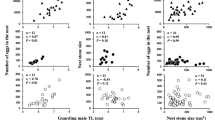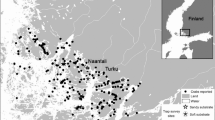Abstract
Nest construction by males is a common reproductive strategy in fishes, but little is known about intra-specific variation in nesting behavior and reproductive interactions with other species. In the southeastern USA, reproductive interactions between bluehead chub (Nocomis leptocephalus) and their nest associate, such as yellowfin shiner (Notropis lutipinnis), are mutualistic because the shiner requires chub nests to spawn but the chub also benefits from additional shiner eggs by reducing predation risk on their own eggs (i.e., dilution effect). As proxies for reproductive success of bluehead chub, we studied factors affecting their nest size variation and utilization by yellowfin shiner in three streams in the upper Piedmont region of South Carolina, USA. A total of 92 nests (71 spawned and 21 abandoned) were located, and we recorded spawning activity, nest size, number and size of male bluehead chub, number of yellowfin shiner, and environmental variables for 89 consecutive days in 2016. Path analysis showed that larger males spawned earlier in the season than smaller males, and instances of pebble re-use for nest construction increased through the spawning season, which extended from April to June. Larger males more likely shared the same nest with each other than smaller males, and larger or more males constructed larger nests and attracted more yellowfin shiner. Nest size also increased when males re-used substrate materials from old nests, and nests built in this manner (36 nests) were equally prevalent as newly constructed nests (35 nests). This study suggests that complex mechanisms mediate host nest size and interactions with nest associates, and individual variation likely shapes dynamics of the mutualistic reproductive interaction.





Similar content being viewed by others
References
Barber I (2013) The evolutionary ecology of nest construction: insight from recent fish studies. Avian Biol Res 6:83–98
Blais JC, Rico C, Bernatchez L (2004) Nonlinear effects of female mate choice in wild threespine sticklebacks. Evolution 58:2498–2510
Bolton C, Peoples BK, Frimpong EA (2015) Recognizing gape limitation and interannual variability in bluehead chub nesting microhabitat use in a small Virginia stream. J Freshw Ecol 30:503–511
Cashner MF, Bart HL (2010) Reproductive ecology of nest associates: use of RFLPs to identify cyprinid eggs. Copeia 2010:554–557
Chin-Baarstad A, Klug H, Lindström K (2009) Should you eat your offspring before someone else does? Effect of an egg predator on filial cannibalism in the sand goby. Anim Behav 78:203–208
Clutton-Brock T (2002) Breeding together: kin selection and mutualism in cooperative vertebrates. Science 296:69–72
Díaz-Muñoz SL, DuVal EH, Krakauer AH, Lacey EA (2014) Cooperating to compete: altruism, sexual selection and causes of male reproductive cooperation. Anim Behav 88:67–78
Enders CK (2001) The impact of nonnormality on full information maximum-likelihood estimation for structural equation models with missing data. Psychol Methods 6:352–370
Gross MR (2005) The evolution of parental care. Q Rev Biol 80:37–45
Jenkins RE, Burkhead NM (1994) Freshwater fishes of Virginia. American Fisheries Society, Bethesda
Johnston CE, Page LM (1992) The evolution of complex reproductive strategies in North American minnows (Cyprinidae). In: Systematics, historical ecology, and North American freshwater fishes. Stanford University Press, Stanford
Johnston CE (1994a) The benefit to some minnows of spawning in the nests of other species. Environ Biol Fish 40:213–218
Johnston CE (1994b) Nest association in fishes: evidence for mutualism. Behav Ecol Sociobiol 35:379–383
Kim S, Kanno Y (2020) Spawning periodicity and synchrony of bluehead chub (Nocomis leptocephalus) and a nest associate, yellowfin shiner (Notropis lutipinnis), across local stream. Ecol Freshw Fish 29:299–310
Kline RB (2011) Principles and practice of structural equation modeling, 3rd edn. Guilford Press, New York
Lanchner EA (1952) Studies of the biology of the cyprinid fishes of the chub genus Nocomis of northeastern United States. Am Midl Nat 120:433–466
Lehtonen TK, Rintakoski S, Lindström K (2007) Mate preference for multiple cues: interplay between male and nest size in the sand goby, Pomatoschistus minutus. Behav Ecol 18:696–700
Lehtonen TK, Lindström K, Wong BBM (2015) Body size mediates social and environmental effects on nest building behaviour in a fish with paternal care. Oecologia 178:699–706
Lindström K (1992) The effect of resource holding potential, nest size, and information about resource quality on the outcome of intruder-owner conflicts in the sand goby. Behav Ecol Sociobiol 30:53–58
Marcy BC Jr, Fletcher DE, Martin FD, Paller MH, Reichert MJM (2005) Fishes of the Middle Savannah River Basin: with emphasis on the Savannah River Site. University of Georgia Press, Athens
Maurakis EG, Woolcott WS, Sabaj MH (1991) Reproductive-behavioral phylogenetics of Nocomis species-groups. Am Midl Nat 126:103–110
McManamay RA, Orth DJ, Dolloff CA, Cantrell MA (2010) Gravel addition as a habitat restoration technique for tailwaters. N Am J Fish Manage 30:1238–1257
Oliveira RF, Almada VC, Forsgren E, Gonçalves EJ (1999) Temporal variation in male traits, nesting aggregations and mating success in the peacock blenny. J Fish Biol 54:499–512
Peoples BK, Tainer MB, Frimpong EA (2011) Bluehead chub nesting activity: a potential mechanism of population persistence in degraded stream habitats. Environ Biol Fish 90:379–391
Peoples BK, McManamay RA, Orth DJ, Frimpong EA (2014) Nesting habitat use by river chubs in a hydrologically variable Appalachian tailwater. Ecol Freshw Fish 23:283–293
Peoples BK, Frimpong EA (2016) Context-dependent outcomes in a reproductive mutualism between two freshwater fish species. Ecol Evol 6:1214–1223
Peoples BK, Floyd SP, Frimpong EA (2016) Nesting microhabitat comparison of Central stoneroller and Bluehead chub: potential inference for host-switching by nest associates. J Freshw Ecol 31:251–259
Petraitis PS, Dunham AE, Niewiarowski PH (1996) Inferring multiple causality: the limitations of path analysis. Funct Ecol 10:421–431
R Development Core Team (2018) R: A Language and Environment for Statistical Computing. R Foundation for Statistical Computing, Vienna
Reighard J (1920) The breeding behavior of the suckers and minnows. I. The suckers. Biol Bull 38:1–32
Reighard J (1943) The breeding habits of the river chub, Nocomis micropogon (Cope). Mich Acad 28:397–423
Rosseel Y (2012) lavaan: An R package for structural equation modeling. J Stat Softw 48:1–36
Rushbrook BJ, Head ML, Katsiadaki I, Barber I (2010) Flow regime affects building behaviour and nest structure in sticklebacks. Behav Ecol Sociobiol 64:1927–1935
Sabaj MH, Maurikis EG, Woolcott WS (2000) Spawning behaviors in the bluehead chub, Nocomis leptocephalus, river chub, Nocomis micropogon and central stoneroller, Campostoma anomalum. Am Midl Nat 144:187–201
Shao B (1997) Nest association of pumpkinseed, Lepomis gibbosus, and golden shiner, Notemigonus crysoleucas. Environ Biol Fish 50:41–48
Shipley B (2000) A new inferential test for path models based on directed acyclic graphs. Struct Equ Modeling 7:206–218
Shipley B (2002) Cause and correlation in biology: a user’s guide to path analysis, structural equations, and causal inference. Cambridge University Press, New York
Silknetter S, Kanno Y, Kanapeckas Métris KL, Cushman E, Darden TL, Peoples BK (2019) Mutualism or parasitism: partner abundance affects host fitness in a fish reproductive interaction. Freshwater Biol 64:174–182
Sinervo B, Zamudio KR (2001) The evolution of alternative reproductive strategies: fitness differential, heritability, and genetic correlation between the sexes. J Hered 92:198–205
Suski CD, Ridgway MS (2007) Climate and body size influence nest survival in a fish with parental care. J Animal Ecol 76:730–739
Taborsky M (1994) Sneakers, satellites, and helpers: parasitic and cooperative behavior in fish reproduction. Adv Study Behav 23:1–100
Vile D, Shipley B, Garnier E (2006) A structural equation model to integrate changes in functional strategies during old-field succession. Ecology 87:504–517
Wallin JE (1989) Bluehead chub (Nocomis leptocephalus) nests used by yellowfin shiners (Notropis lutipinnis). Copeia 4:1077–1080
Wallin JE (1992) The symbiotic nest association of yellowfin shiners, Notropis lutipinnis, and bluehead chubs, Nocomis leptocephalus. Environ Biol Fish 33:287–292
Wisenden BD (1999) Alloparental care in fishes. Rev Fish Biol Fisher 9:45–70
Wong BBM, Candolin U, Lindström K (2007) Environmental deterioration compromises socially enforced signals of male quality in three-spined sticklebacks. Am Nat 170:184–189
Acknowledgements
This research was financially supported by the Creative Inquiry program for undergraduate research and the College of Agriculture, Forestry, and Life Sciences at Clemson University, and the Warner College of Natural Resources at Colorado State University. Additionally, this work was funded in part by the NIFA/USDA under project number SC-1700531. This work represents technical contribution number 6871 of the Clemson Experiment Station. Field assistance was provided by Kimberly Acevedo, Brett Kelly, Ryan Martin, Edward Stello, Alisha Smith, and Seth Mycko. Earlier versions of this manuscript were greatly improved by constructive comments by Lisa Angeloni, Kevin Bestgen, Kasey Pregler, and two anonymous reviewers.
Author information
Authors and Affiliations
Corresponding author
Additional information
Publisher's Note
Springer Nature remains neutral with regard to jurisdictional claims in published maps and institutional affiliations.
Electronic supplementary material
ESM 1
(DOCX 55 kb)
Rights and permissions
About this article
Cite this article
Kim, S., Peoples, B.K. & Kanno, Y. Diverse reproductive patterns of Bluehead Chub (Nocomis leptocephalus) and their relationships with nest size and interactions with an associate, Yellowfin Shiner (Notropis lutipinnis). Environ Biol Fish 103, 783–794 (2020). https://doi.org/10.1007/s10641-020-00980-x
Received:
Revised:
Accepted:
Published:
Issue Date:
DOI: https://doi.org/10.1007/s10641-020-00980-x




